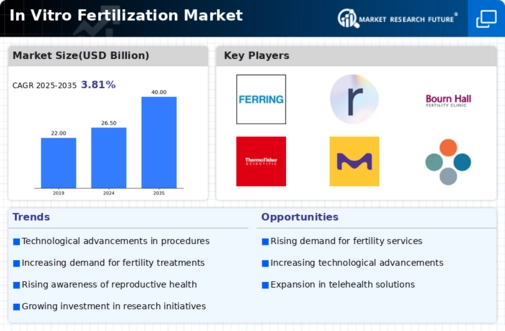Changing Societal Norms
Shifting societal attitudes towards family planning and reproductive health are significantly impacting the In Vitro Fertilization Market. As societal norms evolve, there is a growing acceptance of assisted reproductive technologies, including IVF. This change is particularly evident among younger generations who prioritize career and personal development before starting families. Consequently, more individuals are opting for IVF as a means to achieve their reproductive goals. Additionally, the increasing visibility of diverse family structures, including single parents and same-sex couples, is further driving demand for IVF services. This cultural shift suggests that the In Vitro Fertilization Market will continue to expand as it becomes more inclusive and accessible to a wider range of individuals seeking fertility solutions.
Rising Infertility Rates
The increasing prevalence of infertility is a primary driver for the In Vitro Fertilization Market. Factors such as delayed childbearing, lifestyle changes, and environmental influences contribute to this trend. According to recent statistics, infertility affects approximately 10-15% of couples worldwide, leading to a heightened demand for assisted reproductive technologies. As more individuals seek solutions to their fertility challenges, the In Vitro Fertilization Market is poised for growth. This rising demand is further supported by the increasing number of fertility clinics and advancements in reproductive technologies, which enhance the success rates of IVF procedures. Consequently, the market is likely to expand as more couples turn to IVF as a viable option for achieving parenthood.
Technological Innovations
Technological advancements play a crucial role in shaping the In Vitro Fertilization Market. Innovations such as preimplantation genetic testing, cryopreservation techniques, and improved embryo culture systems have significantly enhanced the success rates of IVF procedures. For instance, the introduction of time-lapse imaging technology allows for better monitoring of embryo development, leading to more informed decisions regarding embryo selection. As these technologies continue to evolve, they not only improve outcomes but also attract more patients to fertility clinics. The market is expected to benefit from ongoing research and development efforts aimed at refining IVF techniques, thereby increasing accessibility and affordability for a broader demographic. This trend suggests a promising future for the In Vitro Fertilization Market as it adapts to the needs of modern patients.
Government Support and Funding
Government initiatives and funding programs are increasingly influencing the In Vitro Fertilization Market. Many countries are recognizing the importance of addressing infertility as a public health issue and are implementing policies to support assisted reproductive technologies. This includes financial assistance for IVF treatments, which can alleviate the financial burden on couples seeking fertility solutions. In some regions, government-funded programs have led to a notable increase in IVF procedures, thereby driving market growth. Furthermore, public awareness campaigns aimed at educating individuals about fertility options are likely to enhance the acceptance of IVF. As governments continue to invest in reproductive health, the In Vitro Fertilization Market is expected to experience sustained growth, reflecting a commitment to improving family planning and reproductive health outcomes.
Increased Investment in Fertility Clinics
The proliferation of fertility clinics and increased investment in reproductive health services are pivotal drivers of the In Vitro Fertilization Market. As demand for IVF services rises, entrepreneurs and healthcare providers are establishing new clinics to cater to this growing need. This trend is supported by the increasing availability of specialized training for fertility specialists and advancements in clinic management technologies. Moreover, the competitive landscape among fertility clinics is likely to lead to improved service offerings and patient experiences. As more clinics emerge, the accessibility of IVF treatments is expected to improve, potentially lowering costs and enhancing success rates. This influx of investment and innovation within the sector indicates a robust future for the In Vitro Fertilization Market, as it adapts to meet the evolving needs of patients.

















Leave a Comment